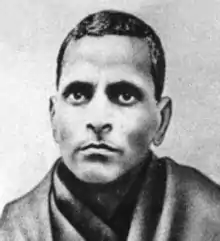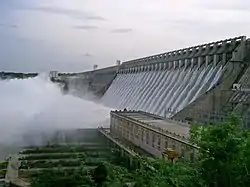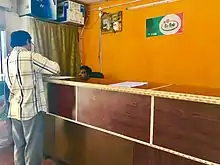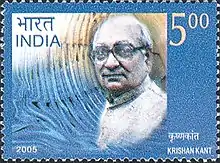Andhra Pradesh (1956–2014)
Andhra Pradesh, retrospectively referred to as United Andhra Pradesh, Undivided Andhra Pradesh or Ummadi Andhra Pradesh, was a state in India formed by States Reorganisation Act, 1956 with Hyderabad as its capital and was reorganised by Andhra Pradesh Reorganisation Act, 2014. The state was made up of three distinct cultural regions of Telangana, Rayalaseema, and Coastal Andhra. Before the 1956 reorganisation Telangana had been part of Hyderabad State ruled by Nizam of Hyderabad, whereas Rayalaseema and Coastal Andhra had been part of Andhra State, formerly a part of Madras Presidency ruled by British India.
| Andhra Pradesh Um'maḍi Āndhrapradēś ఉమ్మడి ఆంధ్రప్రదేశ్ | |||||||||||||
|---|---|---|---|---|---|---|---|---|---|---|---|---|---|
| Former State of India | |||||||||||||
| 1956–2014 | |||||||||||||
 Coat of arms
| |||||||||||||
.svg.png.webp) Map of the United Andhra Pradesh | |||||||||||||
| Capital | Hyderabad | ||||||||||||
| History | |||||||||||||
| Government | |||||||||||||
| • Type | Federated state | ||||||||||||
| Chief Minister | |||||||||||||
• 1956-1960 | Neelam Sanjiva Reddy (First) | ||||||||||||
• 2010-2014 | Kiran Kumar Reddy (Last) | ||||||||||||
| Governor | |||||||||||||
• 1956-1957 | Chandulal Madhavlal Trivedi (First) | ||||||||||||
• 2009-2014 | E. S. L. Narasimhan (Last) | ||||||||||||
| History | |||||||||||||
• State established | 1 November 1956 | ||||||||||||
• State bifurcated | 2 June 2014 | ||||||||||||
| |||||||||||||

.svg.png.webp)
Creation of United Andhra Pradesh


In an effort to gain an independent state based on linguistic identity, and to protect the interests of the Telugu people of Madras State, Potti Sreeramulu fasted to death in 1952. As Madras became a bone of contention, in 1949 a JVP committee report stated: "Andhra Province could be formed provided the Andhras give up their claim on the city of Madras (now Chennai)". After Potti Sreeramulu's death, the Telugu-speaking area of Andhra State was carved out of Madras State on 30 November 1953, with Kurnool as its capital city.[1] On the basis of the gentlemen's agreement of 1 November 1956, the States Reorganisation Act formed Andhra Pradesh by merging Andhra State with the Telugu-speaking areas of the already existing Hyderabad State.[2] Hyderabad was made the capital of the new state. The Marathi-speaking areas of Hyderabad State merged with Bombay State which later bifurcated in Gujarat and Maharashtra and the Kannada-speaking areas were merged with Mysore State which was later renamed as Karnataka.[3]
In February 2014, the Andhra Pradesh Reorganisation Act, 2014 bill was passed by the Parliament of India for the formation of the Telangana state comprising ten districts. Hyderabad will remain as a joint capital for not exceeding ten years.[4] The new state of Telangana came into existence on 2 June 2014 after approval from the President of India.[5] Number of petitions questioning the validity of Andhra Pradesh Reorganisation Act, 2014 is long pending for the verdict since April 2014 before the supreme court constitutional bench.[6][7]
The Visalandhra, Vishalandhra or Vishala Andhra was a movement in post-independence India for a united state for all Telugu speakers, a Greater Andhra (Telugu: విశాలాంధ్ర Viśālāndhra). This movement was led by the Communist Party of India under the banner of Andhra Mahasabha with a demand to merge all the Telugu-speaking areas into one state. (The Communist Party of India demanded for the formation of similar linguistic states across India.) The movement succeeded and a separate state of Andhra Pradesh was formed by merging Telugu-speaking areas of Hyderabad State (Telangana) with Andhra State on 1 November 1956 as part of the States Reorganisation Act. (Andhra State had been previously carved out of Madras State on 1 October 1953.) However, on 2 June 2014, Telangana State was separated back out of Andhra Pradesh and the Vishalandhra experiment came to an end. The residual Andhra Pradesh now has approximately the same borders.
History
 Potti Sreeramulu, whose fast unto death in 1952 led to the formation of Andhra State
Potti Sreeramulu, whose fast unto death in 1952 led to the formation of Andhra State Nagarjuna Sagar Dam (completed in 1967)
Nagarjuna Sagar Dam (completed in 1967) NT Rama Rao, a film actor, who became chief minister of Andhra Pradesh in 1983
NT Rama Rao, a film actor, who became chief minister of Andhra Pradesh in 1983 Mee Seva office (initial launch of the E-Seva Project in 2001)
Mee Seva office (initial launch of the E-Seva Project in 2001)
In an effort to gain an independent state based on linguistic identity and to protect the interests of the Telugu-speaking people of Madras State, Potti Sreeramulu fasted to death in 1952. As the city of Madras became a bone of contention, in 1949 a committee with Jawaharlal Nehru, Vallabhbhai Patel, and Pattabhi Sitaramayya was constituted. The committee recommended that Andhra State could be formed provided the Andhras gave up their claim on the city of Madras (now Chennai). After Potti Sreeramulu's death, the Telugu-speaking area of Andhra State was carved out of Madras State on 1 October 1953, with Kurnool as its capital city. Tanguturi Prakasam became the first chief minister. On the basis of the Gentlemen's Agreement of 1956, the States Reorganisation Act created Andhra Pradesh by merging the neighbouring Telugu-speaking areas of the Hyderabad State with Hyderabad as the capital on 1 November 1956.[8]
The Indian National Congress (INC) ruled the state from 1956 to 1982. Neelam Sanjiva Reddy became the first chief minister. Among other chief ministers, P. V. Narasimha Rao is known for implementing land reforms and land ceiling acts and securing reservation for lower castes in politics.[9] Nagarjuna Sagar Dam, completed in 1967, and Srisailam Dam, completed in 1981, are some of the irrigation projects that helped increase the production of paddy in the state.[10]
In 1983, the Telugu Desam Party (TDP) won the state elections, and N. T. Rama Rao became the chief minister of the state for the first time after launching his party just nine months earlier.[11] This broke the long-time single-party monopoly enjoyed by the INC. He transformed the sub-district administration by forming mandals in place of earlier taluks, removing hereditary village heads, and appointing non-hereditary village revenue assistants.[12] The 1989 elections ended the rule of Rao, with the INC returning to power with Marri Chenna Reddy at the helm. In 1994, Andhra Pradesh gave a mandate to the Telugu Desam Party again, and Rao became the chief minister again. Nara Chandrababu Naidu, Rao's son-in-law, came to power in 1995 with the backing of a majority of the MLAs. The Telugu Desam Party won both the assembly and Lok Sabha elections in 1999 under the leadership of Chandrababu Naidu. Thus, Naidu held the record for the longest-serving chief minister (1995–2004) of the united Andhra Pradesh.[13] He introduced e-governance by launching e-Seva centres in 2001 for paperless and speedy delivery of government services. He is credited with transforming Hyderabad into an IT hub by providing incentives for tech companies to set up centres.[14]
In 2004, Congress returned to power with a new chief ministerial face, YS Rajashekara Reddy, better known as YSR. The main emphasis during Reddy's tenure was on social welfare schemes such as free electricity for farmers, health insurance, tuition fee reimbursement for the poor, and the national rural employment guarantee scheme. He took over the free emergency ambulance service initiated by a corporation and ran it as a government project. INC won the 2009 elections under the leadership of YSR in April.[15] He was elected chief minister again but was killed in a helicopter crash that occurred in September 2009. He was succeeded by Congressmen Konijeti Rosaiah and Nallari Kiran Kumar Reddy; the latter resigned over the impending division of the state to form Telangana.[16]
During its 58 years as a unified state, the state weathered separatist movements from Telangana (1969) and Andhra (1972) successfully.[17] A new party called Telangana Rashtra Samithi, formed in April 2001 by Kalvakuntla Chandrashekar Rao (KCR), reignited the Telanganga movement. A joint action committee formed with political parties, government employees, and the general public spearheaded the agitation. When KCR's health deteriorated due to his fast-unto-death programme, the central government decided to initiate the process to form an independent Telangana in December 2009. This triggered the Samaikyandhra movement to keep the state united. The Srikrishna committee was formed to give recommendations on how to deal with the situation. It gave its report in December 2010.[18] The agitations continued for nearly 5 years, with the Telangana side harping on the marginalisation of food culture, language, and unequal economic development and the Samaikyandhra movement focusing on the shared culture, language, customs, and historical unity of Telugu-speaking regions.[19] The Andhra Pradesh Reorganisation Act bill was passed by the parliament of India for the formation of the Telangana state, comprising ten districts, despite opposition by the state legislature.[20] The bill included the provision to retain Hyderabad as the capital for up to ten years and the provision to ensure access to educational institutions for the same period.[21] The bill received the assent of the president and was published in the gazette on 1 March 2014.[22] The new state of Telangana came into existence on 2 June 2014 after approval from the president of India, with the residual state continuing as Andhra Pradesh.[23] The present form of Andhra Pradesh is the same as that of Andhra State, except for Bhadrachalam town, which continues in Telangana.[24] A number of petitions questioning the validity of the Andhra Pradesh Reorganisation Act have been pending before the Supreme Court constitutional bench since April 2014.[25]
In the final elections held in the unified state in 2014, the TDP got a mandate in its favour, defeating its nearest rival, the YSR Congress Party, a breakaway faction of the Congress founded by Y. S. Jagan Mohan Reddy, son of former Chief Minister Y. S. Rajasekhara Reddy. N. Chandrababu Naidu, the chief of the TDP, became the chief minister on 8 June 2014.[26] In 2017, the government of Andhra Pradesh began operating from its new greenfield capital, Amaravati, for which 33,000 acres were acquired from farmers through an innovative land pooling scheme.[27][28] Interstate issues with Telangana relating to the division of assets of public sector institutions and organisations of the united state and the division of river waters are not yet resolved.[29][30]
United Andhra Pradesh demographics
| Year | Pop. | ±% |
|---|---|---|
| 1961 | 35,983,000 | — |
| 1971 | 43,503,000 | +20.9% |
| 1981 | 53,550,000 | +23.1% |
| 1991 | 66,508,000 | +24.2% |
| 2001 | 75,727,000 | +13.9% |
| 2011 | 84,665,533 | +11.8% |
| Includes Telangana. Source: Census of India[31] | ||
List of governors of United Andhra Pradesh
Data from Andhra Pradesh State Portal.[32]
- Main article List of governors of Andhra Pradesh
| # | Name | Portrait | From | To | Term length |
|---|---|---|---|---|---|
| 1 | Chandulal Madhavlal Trivedi |  |
1 November 1956 | 1 August 1957 | 1,005 days |
| 2 | Bhim Sen Sachar |  |
1 August 1957 | 8 September 1962 | 1,865 days |
| 3 | Satyawant Mallannah Shrinagesh |  |
8 September 1962 | 4 May 1964 | 605 days |
| 4 | Pattom A. Thanu Pillai | 4 May 1964 | 11 April 1968 | 1,439 days | |
| 5 | Khandubhai Kasanji Desai | – | 11 April 1968 | 25 January 1975 | 2,481 days |
| 6 | S. Obul Reddy | – | 25 January 1975 | 10 January 1976 | 351 days |
| 7 | Mohanlal Sukhadia |  |
10 January 1976 | 16 June 1976 | 159 days |
| 8 | Ramchandra Dhondiba Bhandare | – | 16 June 1976 | 17 February 1977 | 247 days |
| 9 | B. J. Divan | – | 17 February 1977 | 5 May 1977 | 78 days |
| 10 | Sharda Mukherjee | – | 5 May 1977 | 15 August 1978 | 468 days |
| 11 | K. C. Abraham | – | 15 August 1978 | 15 August 1983 | 1,827 days |
| 12 | Thakur Ram Lal |  |
15 August 1983 | 29 August 1984 | 381 days |
| 13 | Shankar Dayal Sharma |  |
29 August 1984 | 26 November 1985 | 455 days |
| 14 | Kumud Ben Joshi | – | 26 November 1985 | 7 February 1990 | 1,535 days |
| 15 | Krishan Kant |  |
7 February 1990 | 22 August 1997 | 2,754 days |
| 16 | Gopala Ramanujam | – | 22 August 1997 | 24 November 1997 | 95 days |
| 17 | C. Rangarajan | .jpg.webp) |
24 November 1997 | 3 January 2003 | 1,867 days |
| 18 | Surjit Singh Barnala |  |
3 January 2003 | 4 November 2004 | 672 days |
| 19 | Sushilkumar Shinde |  |
4 November 2004 | 29 January 2006 | 452 days |
| 20 | Rameshwar Thakur |  |
29 January 2006 | 22 August 2007 | 571 days |
| 21 | N. D. Tiwari |  |
22 August 2007 | 27 December 2009 | 859 days |
| 22 | E. S. L. Narasimhan |  |
28 December 2009[33] | 1 June 2014 | 1,617 days |
List of chief ministers of United Andhra Pradesh
On 1 November 1956, Hyderabad State ceased to exist; its Gulbarga and Aurangabad divisions were merged into Mysore State and Bombay State respectively. Its remaining Telugu-speaking portion, Telangana, was merged with Andhra State to form the new state of United Andhra Pradesh.
N. Chandrababu Naidu of Telugu Desam Party was the longest served chief minister of United Andhra Pradesh. Kiran Kumar Reddy of the Indian National Congress was the last chief minister of United Andhra Pradesh.
| No. | Portrait | Name | Constituency | Term of office | Assembly
(election) |
Party | |||
|---|---|---|---|---|---|---|---|---|---|
| From | To | Days in office | |||||||
| 1 | .jpg.webp) |
Neelam Sanjiva Reddy | Kalahasti | 1 November 1956 | 11 January 1960 | 3 years, 71 days | 1st | Indian National Congress | |
| 2nd | |||||||||
| 2 |  |
Damodaram Sanjivayya | Kurnool | 11 January 1960 | 12 March 1962 | 2 years, 60 days | |||
|
(1) |
.jpg.webp) |
Neelam Sanjiva Reddy | Dhone | 12 March 1962 | 20 February 1964 | 2 years, 8 days | 3rd | ||
| 3 |  |
Kasu Brahmananda Reddy | Narasaraopet | 21 February 1964 | 30 September 1971 | 7 years, 221 days | |||
| 4th | |||||||||
| 4 | (2).jpg.webp) |
P. V. Narasimha Rao | Manthani | 30 September 1971 | 10 January 1973 | 1 year, 102 days | |||
| 5th | |||||||||
| – |  |
Vacant (President's rule) |
N/A | 11 Jan 1973 | 10 December 1973 | 333 days | N/A | ||
| 5 | Jalagam Vengala Rao | Vemsoor | 10 December 1973 | 6 March 1978 | 4 years, 86 days | Indian National Congress | |||
| 6 | .jpg.webp) |
Marri Chenna Reddy | Medchal | 6 March 1978 | 11 October 1980 | 2 years, 219 days | 6th | ||
| 7 | T. Anjaiah | MLC | 11 October 1980 | 24 February 1982 | 1 year, 136 days | ||||
| 8 | Bhavanam Venkatarami Reddy | MLC | 24 February 1982 | 20 September 1982 | 208 days | ||||
| 9 | .jpg.webp) |
Kotla Vijaya Bhaskara Reddy | Kurnool | 20 September 1982 | 9 January 1983 | 111 days | |||
| 10 |  |
N. T. Rama Rao | Tirupati | 9 January 1983 | 16 August 1984 | 1 year, 220 days | 7th | Telugu Desam Party | |
| 11 |  |
N. Bhaskara Rao | Vemuru | 16 August 1984 | 16 September 1984 | 31 days | |||
| (10) |  |
N. T. Rama Rao | Hindupuram | 16 September 1984 | 9 March 1985 | 5 years, 77 days | |||
| 9 March 1985 | 2 December 1989 | 8th | |||||||
| (6) | .jpg.webp) |
Marri Chenna Reddy | Sanathnagar | 3 December 1989 | 17 December 1990 | 1 year, 14 days | 9th | Indian National Congress | |
| 12 |  |
N. Janardhana Reddy | Venkatagiri | 17 December 1990 | 9 October 1992 | 1 year, 297 days | |||
| (9) | .jpg.webp) |
Kotla Vijaya Bhaskara Reddy | Panyam | 9 October 1992 | 12 December 1994 | 2 years, 64 days | |||
| (10) |  |
N. T. Rama Rao | Hindupur | 12 December 1994 | 1 September 1995 | 263 days | 10th | Telugu Desam Party | |
| 13 |  |
N. Chandrababu Naidu | Kuppam | 1 September 1995 | 11 October 1999 | 8 years, 255 days | |||
| 11 October 1999 | 13 May 2004 | 11th | |||||||
| 14 |  |
Y. S. Rajasekhara Reddy | Pulivendla | 14 May 2004 | 20 May 2009 | 5 years, 111 days | 12th | Indian National Congress | |
| 20 May 2009 | 2 September 2009 | 13th | |||||||
| 15 |  |
Konijeti Rosaiah | MLC | 3 September 2009 | 24 November 2010 | 1 year, 82 days | |||
| 16 |  |
Kiran Kumar Reddy | Pileru | 25 November 2010 | 1 March 2014 | 3 years, 96 days | |||
| – |  |
Vacant[lower-alpha 1] (President's rule) |
N/A | 2 March 2014 | 1 June 2014 | 91 days | N/A | ||
List of deputy chief ministers of United Andhra Pradesh
The list of deputy chief ministers in the Indian former state of United Andhra Pradesh include:
Keys: INC
| Sr. No. | Portrait | Name | Took office | Left office | Political party | Chief Minister | |
|---|---|---|---|---|---|---|---|
| 1 |  |
Konda Venkata Ranga Reddy | 1959 | 1962 | Indian National Congress | Neelam Sanjeeva Reddy | |
| 2 |  |
J.V. Narsing Rao | 1967 | 1972 | Indian National Congress | Kasu Brahmananda Reddy | |
| 3 | C. Jagannatha Rao | 24 February 1982 | 20 September 1982 | Indian National Congress | Bhavanam Venkatarami Reddy | ||
| 4 | Koneru Ranga Rao | 9 October 1992 | 12 December 1994 | Indian National Congress | Kotla Vijaya Bhaskara Reddy | ||
| 5 |  |
Damodar Raja Narasimha | 10 June 2011[35] | 1 February 2014[36] | Indian National Congress | N. Kiran Kumar Reddy | |
Creation of Telangana
After several years of protest and agitation, the central government, under the United Progressive Alliance, decided to bifurcate the existing Andhra Pradesh state and on 2 June 2014, the Union Cabinet unilaterally cleared the bill for the creation of Telangana. Lasting for almost 5 decades, it was one of the most long lasting movements in South India.[1] On 18 February 2014, the Lok Sabha passed the bill with a voice vote. Subsequently, the bill was passed by the Rajya Sabha two days later, on 20 February.[2] As per the bill, Hyderabad would be the capital of Telangana, while the city would also remain the capital of residual state of Andhra Pradesh for no more than ten years. At present, Hyderabad is the de jure joint capital. On 2 June 2014, Telangana was created.
The Telangana movement refers to a movement for the creation of a state, Telangana, from the pre-existing state of Andhra Pradesh in India. The new state corresponds to the Telugu-speaking portions of the erstwhile princely state of Hyderabad.
Notes
- President's rule may be imposed when the "government in a state is not able to function as per the Constitution", which often happens because no party or coalition has a majority in the assembly. When President's rule is in force in a state, its council of ministers stands dissolved. The office of chief minister thus lies vacant, and the administration is taken over by the governor, who functions on behalf of the central government. At times, the legislative assembly also stands dissolved.[34]
References
- "Post-Independence Era, then and now". aponline.gov.in. Archived from the original on 20 December 2013. Retrieved 3 August 2013.
- "Know Hyderabad: History". Pan India Network. 2010. Archived from the original on 21 September 2010. Retrieved 5 October 2010.
- "How Andhra Pradesh celebrated its formation day". Live Mint. 1 November 2013. Retrieved 18 September 2019.
- "The Andhra Pradesh Reorganisation Act, 2014" (PDF). India Code Legislative Department. Ministry of Law and Justice. 1 March 2014. p. 2. Archived from the original (PDF) on 24 September 2015. Retrieved 14 July 2015.
- "Telangana State to Be Born on June 2". The New Indian Express. IANS. Archived from the original on 6 July 2014. Retrieved 20 February 2020.
- "Supreme court refers Telangana petitions to constitution bench". NDTV. Archived from the original on 29 November 2014. Retrieved 17 February 2016.
- "The story of India's 29th State — Telangana". The Hindu. 1 June 2016. Retrieved 18 September 2019.
- "Post-independence era, then and now". aponline.gov.in. Archived from the original on 20 December 2013. Retrieved 3 August 2013.
- "P.V. Narasimha Rao". Encyclopedia Britannica. 17 May 2023. Archived from the original on 2 June 2023. Retrieved 1 June 2023.
- B, M K Reddy; K, S Reddy. "Irrigation development in Andhra Pradesh" (PDF). Archived (PDF) from the original on 1 June 2023. Retrieved 1 June 2023.
- "N.T. Rama Rao: A timeline". The Hindu. 28 May 2017. Archived from the original on 1 June 2023. Retrieved 1 June 2023.
- Vaddiraju, Anil kumar (21 March 2020). "The mandal System in Telangana and Andhra Pradesh" (PDF). Economic & Political Weekly. LV (12). Archived (PDF) from the original on 1 June 2023. Retrieved 1 June 2023.
- Length of time as chief minister. Archived from the original on 10 September 2014. Retrieved 20 December 2013.
- "KTR's admission: Chandrababu Naidu helped IT grow in Hyderabad". Economic Times. 15 December 2017. Archived from the original on 1 June 2023. Retrieved 1 June 2023.
- PTI (3 September 2009). "YSR: From aggressive politician to mass leader". The Hindu. Retrieved 20 June 2023.
- "Kiran beats PV, Rosaiah, Anjaiah in tenure". The Hindu. Chennai, India. 25 November 2012. Archived from the original on 20 December 2013. Retrieved 13 April 2021.
- "Bitter memories". Hinduonnet.com. Archived from the original on 22 January 2010. Retrieved 14 September 2010.
{{cite news}}: CS1 maint: unfit URL (link) - Committee for consultations on the situation in Andhra Pradesh Report (PDF). 2010. Archived from the original (PDF) on 15 October 2011.
- Maheshwari, R. Uma (31 July 2013). "A state that must fulfil a higher purpose". The Hindu. ISSN 0971-751X. Archived from the original on 20 July 2020. Retrieved 20 July 2020.
- Jayaprakash Narayan (28 October 2013). "A challenge to Indian federalism". The Hindu. Retrieved 20 June 2023.
- ICLD (2014). The Andhra Pradesh reorganisation act, 2014 (PDF). Ministry of Law and Justice. p. 2. Archived from the original (PDF) on 24 September 2015. Retrieved 14 July 2015.
- "The Andhra Pradesh Reorganisation Act, 2014" (PDF). Ministry of Law and Justice, Government of India. Archived from the original (PDF) on 8 January 2016. Retrieved 3 March 2014.
- "Telangana state formation gazette". The New Indian Express. Archived from the original on 6 July 2014. Retrieved 14 May 2014.
- "Explained: Why was Andhra's three-capital act controversial". NDTV.com. Archived from the original on 22 November 2021. Retrieved 22 November 2021.
- "Supreme court refers Telangana petitions to constitution bench". NDTV. Archived from the original on 29 November 2014. Retrieved 17 February 2016.
- "CBN to be sworn as CM of Andhra on June 8th". Deccan-Journal. Archived from the original on 14 July 2014. Retrieved 2 June 2014.
- "Andhra Pradesh to get new capital Amaravati today, PM Modi to inaugurate". NDTV. 22 October 2015. Archived from the original on 14 April 2021. Retrieved 9 March 2021.
- P, Ashish (2 March 2017). "Chief Minister Chandrababu Naidu inaugurates new Andhra Pradesh assembly". India Today. Archived from the original on 14 April 2021. Retrieved 9 March 2021.
- "Explained : The stalemate between Telangana and AP". The Hindu. 10 January 2023. Archived from the original on 29 May 2023. Retrieved 29 May 2023.
- "Explained : The Telangana- Andhra Pradesh water dispute". The Hindu. 23 May 2023. Archived from the original on 29 May 2023. Retrieved 29 May 2023.
- "Demography" (PDF). Official portal of Andhra Pradesh Government. Government of Andhra Pradesh. Archived from the original (PDF) on 14 July 2014. Retrieved 10 June 2014.
- "List of Governors". AP State Portal. Government of Andhra Pradesh. Archived from the original on 27 August 2018. Retrieved 27 August 2018.
- "E S L Narasimhan takes charge as Andhra Pradesh Governor". The Times of India. Press Trust of India. 28 December 2009.
- Amberish K. Diwanji. "A dummy's guide to President's rule". Rediff.com. 15 March 2005.
- "Raja Narasimha is deputy CM". The Times of India. 11 June 2011. Retrieved 2 February 2022.
- Reddy, B. Muralidhar; Joshua, Anita (28 February 2014). "Andhra Pradesh to be under President's Rule". The Hindu. Retrieved 2 February 2022.